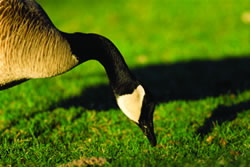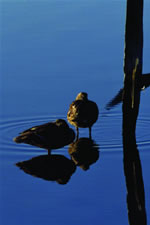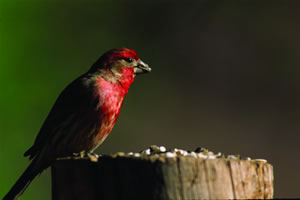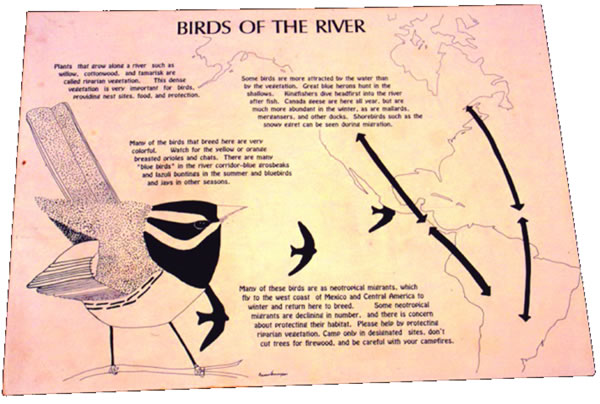I
stand in my backyard and watch as skeins of geese
fly southward. Their V-formation breaks down as birds
drift out of line. The rearrangement resembles a
giant chevron or check mark against the early morning
sky.
 But
birdwatchers are not the only ones who
have looked skyward and read the messages
of migrating birds. Throughout history
our agrarian society has seen the writing
in the sky and the changing of seasons
as flocks of birds move overhead. Of course,
bird migration also takes place at night,
but certain species tend to be noisier
about their journey than others. Historically,
this movement signaled times to harvest
or times to plant, depending upon the year. But
birdwatchers are not the only ones who
have looked skyward and read the messages
of migrating birds. Throughout history
our agrarian society has seen the writing
in the sky and the changing of seasons
as flocks of birds move overhead. Of course,
bird migration also takes place at night,
but certain species tend to be noisier
about their journey than others. Historically,
this movement signaled times to harvest
or times to plant, depending upon the year.
In George C. Bompa’s book Life of Frank Buckland,
he quotes Buckland’s commentary on how European
politics of the early 19th century may have turned
out differently if the Emperor Napoleon had only been
a birdwatcher.
If the Emperor Napoleon, when on the road to Moscow
with his army in 1811, had condescended to observe
the flights of storks and cranes passing over his fated
battalions, subsequent events in the politics of Europe  might
have been very different. These storks and cranes knew
of the coming on of a great and terrible winter, the
birds hastened towards the south, Napoleon and his
army towards the North.” might
have been very different. These storks and cranes knew
of the coming on of a great and terrible winter, the
birds hastened towards the south, Napoleon and his
army towards the North.”
Sometimes it pays to look up.
European politics aside, bird migration is a mixed
bag of awe-inspiring feats to ho-hum movements. There
are species that travel thousands of miles and cross
vast expanses of ocean all on tiny wingbeats.
Birds orient and navigate by a variety of compasses:
the sun, the stars and the magnetic fields of the earth.
Included in their travel bag are their senses of smell,
hearing and sight that also play a role in this process.
Landforms create routes or barriers to migration, and
birds use winds and updrafts off of ridges, canyons
and mountains to aid in their journey. Returning adults
have an advantage of experience over their young, yet
many of these first-time migrants posses an innate
sense as to where they should go.
 Of
the 650 or so bird species that breed in
North America, about 130 are nonmigratory.
These nonmigratory species may not stay put
through the winter, but move locally from
higher to lower elevations or disperse from
their natal (birth) areas to the surrounding
locales. Almost half of all North American
species head south across the border into
Mexico, Central America, the Caribbean, or
South America. These border-crossers are
called “neotropical migrants” after
their New World or Neotropic wintering choice.
Songbirds make up a vast majority of these
travelers. Of
the 650 or so bird species that breed in
North America, about 130 are nonmigratory.
These nonmigratory species may not stay put
through the winter, but move locally from
higher to lower elevations or disperse from
their natal (birth) areas to the surrounding
locales. Almost half of all North American
species head south across the border into
Mexico, Central America, the Caribbean, or
South America. These border-crossers are
called “neotropical migrants” after
their New World or Neotropic wintering choice.
Songbirds make up a vast majority of these
travelers.
The other two-fifths of the birds migrate within (mostly)
the confines of temperate North America. Waterfowl
and many species in the finch and sparrow families
compromise this group. Looking outside my window in
the winter I often see a mix of dark-eyed juncos, white-crowned
sparrows, American goldfinches, and evening grosbeaks
all members from these two families.
 At
times, other species replace their counterparts
who have already moved south. An example
would be robins from Canada showing up while
their Moab relatives have left the area.
The individual’s origin is hard to
discern without either color bands on the
legs or tiny satellite transmitters attached
to their backs, and some locals stick around
throughout the winter anywise; hence, the
mixed bag portion of the migration equation. At
times, other species replace their counterparts
who have already moved south. An example
would be robins from Canada showing up while
their Moab relatives have left the area.
The individual’s origin is hard to
discern without either color bands on the
legs or tiny satellite transmitters attached
to their backs, and some locals stick around
throughout the winter anywise; hence, the
mixed bag portion of the migration equation.
No matter. One given is that there are birds to look
at in November in Moab. The Scott M. Matheson Wetlands
Preserve and the Mill Creek Parkway are a couple of “in-town” areas
that are highly recommended for birdwatching. And maybe
the birds you’ll see will indicate the severity
of the upcoming winter and not leave you going the
wrong way like Emperor Napoleon.

|